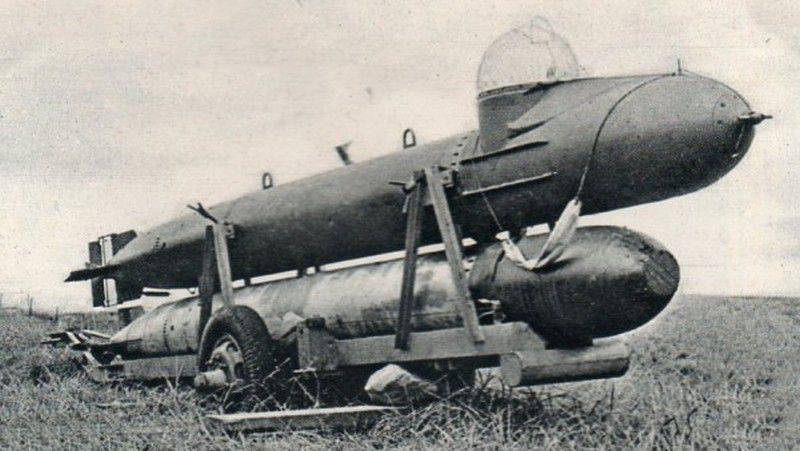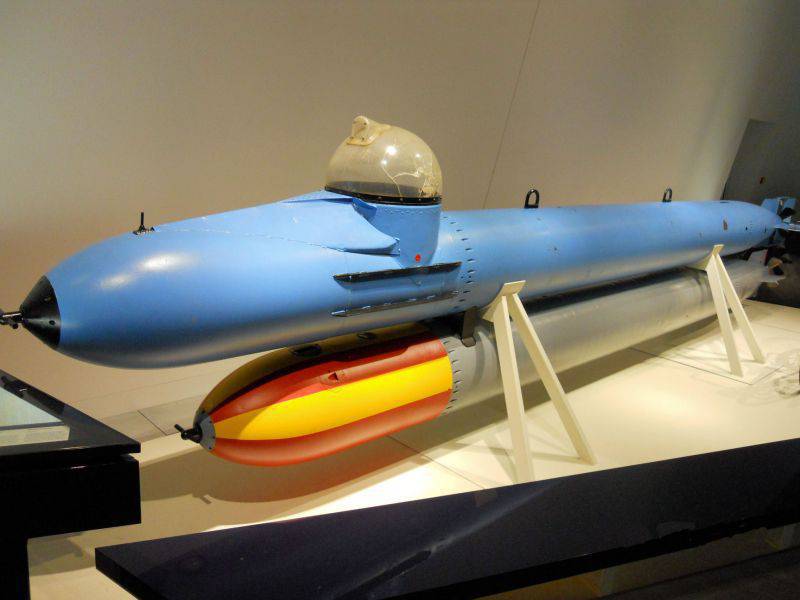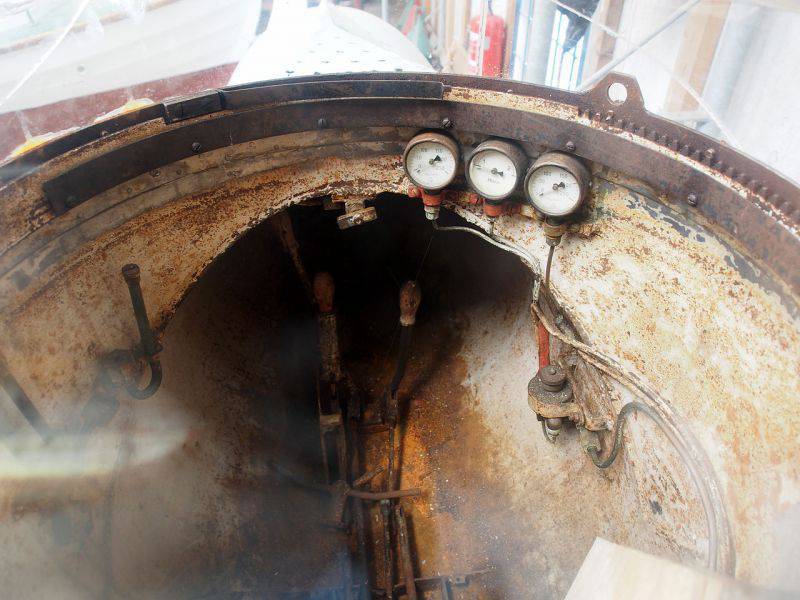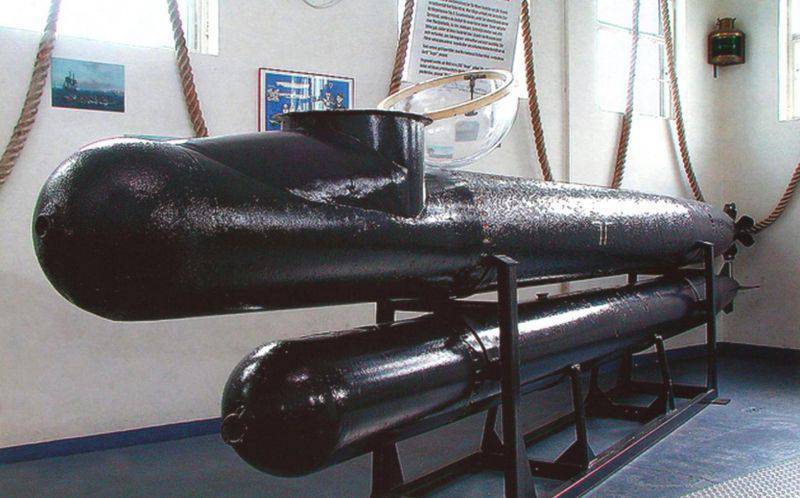Man-controlled torpedo Marder (Germany)
At the end of the spring of 44, the Kleinkampfverbande troops and the Torpedo Research Center weapons started developing a new human-controlled torpedo. The project was named Marder ("Marten"). The purpose of the new development was to improve the design of the Neger torpedo with the correction of existing deficiencies and increase the overall characteristics. In this case, one of the priority tasks of the project was to create a system for immersion and ascent. It was assumed that the ability to go to depth would allow the perspective torpedo to reduce the likelihood of detection by the enemy.
The human-guided torpedo Marder was a direct development of the existing Neger, which resulted in a marked similarity of their designs. Nevertheless, a number of innovations were used in the new project aimed at improving the characteristics of the new technology. The most noticeable consequence of the modifications was the change in the appearance of the controlled module of the torpedo. Due to the installation of several new units, it had to be lengthened. Thus, the existing torpedo “Neger” consisted of two equal parts along the length, and the new “Marder” - from a longer upper and less large lower.

Torpedo Marder on a shipping trolley. Photos Warshipsww2.eu
The overall architecture of the torpedo remained the same. In the combat position of the device Marder consisted of two main parts. In the upper hull of a large elongation there was a pilot, a set of necessary equipment and a power plant designed to sail to the target area and return to the base. The lower "module" was a conventional G7e serial torpedo with an electric motor. After entering the start-up course, the driver had to unhook the combat torpedo, which then independently reached the target.
The Neger manned torpedo block was developed based on the G7e product, removing unnecessary units and installing new equipment. The torpedo Marder had a similar "origin", but its design was a direct development of the Negera. This caused the similarity of the layout, and the new units in the manned corps were associated with updated requirements, formed on the results of operating existing equipment.
When creating a man-controlled torpedo Neger, the base G7e dismantled the warhead, and in its place installed the cockpit. In the Marder project, the bow of the hull was again changed. Before the cab mounted fairing with ballast tank capacity 30 l. This unit weighed torpedo 65 kg, but added to its total volume 0,3 cube. With the help of a ballast tank, the torpedo could sink to a depth of several tens of meters and thus avoid possible pursuit.
The interior of the cockpit has undergone major alterations. The plexiglass dome of the cockpit received new locks and fasteners, facilitating its reset in an emergency situation. A number of new elements appeared on the dashboard to facilitate work in a combat situation. In addition to the Negera instruments, the Marder had a depth gauge with a scale of up to 30 m, pressure indicators in gas cylinders and a cabin, as well as a trim level calculated for angles from -15 ° to + 15 °.
During the operation of existing human-controlled torpedoes, there were a lot of problems with the breathing apparatus of the Dräger system. For this reason, when developing the Marder torpedo, an updated life support system was used. The existing breathing apparatus remained part of the equipment of the torpedo, but became redundant. An oxygen tank was installed near the cabin, from which gas was supplied for the pilot's breathing. It was assumed that the use of an oxygen cylinder and breathing apparatus will significantly reduce the likelihood of unpleasant consequences in the form of problems with the pilot's state of health or his death from hypoxia.

Scheme torpedoes Marder. Figure Warshipsww2.eu
Behind the cockpit in the case was provided a compressed air tank connected to a ballast tank. The volume of the cylinder was determined with the expectation of a tank purge on 20. For obvious reasons, in practice, the air flow rate could exceed the calculated one, which reduced the number of possible dives and ascent.
The layout of the middle and aft hulls of the Marder torpedo guided module was completely borrowed from the previous product of this class. The batteries were located in the middle part of the hull, the 8,8 kW electric motor and the propeller in the stern. Also on the stern of the hull rudders and depths were provided. Unlike the base torpedo G7e, the man-guided vehicles had rather large planes designed for control.
Due to the new ballast tank nose fairing, the length of the Marder torpedo was 8,3 m, i.e. on 65 cm more than Neger. The case diameter has not changed - 533 mm. Also remained the same dimensions of the rudders and other geometric features of the torpedo. The displacement of the “Marten” with a suspended torpedo was 3,5 t.
Despite the weighting of the design, the driving characteristics of the new torpedo remained at the level of the existing sample. The maximum speed in the semi-submerged position reached 8 nodes. In a submerged position, the maximum speed was slightly reduced. However, driving at maximum speed was not recommended. At maximum speed, the electric motor consumed too much energy, which led to a significant reduction in the stroke range. For this reason, it was necessary to approach the target at the economic speed of an 4,2 node when moving on a surface or on an 3,3 node at a shallow depth.
Unlike Neger's torpedoes, the new Marder could, if necessary, dive under the water, hiding from enemy observers. The ballast tank in the nose, according to calculations, allowed to dive to a depth of 30 m. However, in practice, the depth of movement rarely exceeded 20-25 m. Fast diving allowed to go under water in time and thereby reduce the probability of detection. Performing a dive, the torpedo pilot had to monitor the trim sensor. In view of the low seaworthiness of the torpedo, it was necessary to sink and emerge with a trim of no more than 7-8 ° on the bow or stern, respectively.

Torpedo Marder in the Military Historical Museum of the Bundeswehr, Dresden. Photo of Wikimedia Commons
Being a deep modernization of the “Negera”, the new human-controlled torpedo “Marder” was to be operated according to similar methods. The torpedoes were planned to be delivered to the desired area of the coast, where they would be lowered into the water. After that, the drivers should get to the area where the targets are located, distribute the enemy ships among themselves and carry out their attack. To attack, the pilots had to turn in the direction of the target and specify the aiming point using two pins in front of the cockpit. After that, the engine was launched starting torpedoes and its uncoupling.
The G7e torpedo weighed about 1600 kg and carried an explosive charge weighing 280 kg. This weapon was equipped with an electric motor and a battery. The maximum speed depended on the modification of the torpedo. Thus, the product version T2 could reach speeds up to 28-30 nodes. The stroke range was also different. Late torpedoes with reduced speed and increased battery capacity could go up to 7500 m. A sufficiently heavy warhead could inflict serious damage to most anti-Hitler coalition ships. In addition, light ships and boats could be destroyed by a single torpedo.
Thanks to the innovations of the project, the pilot of the torpedo Marder could literally hide from the enemy under water. However, the limited capacity of the compressed air cylinder and the absence of any means of observation forced the driver to travel most of the way in a semi-submerged position, in which the transparent dome of the cabin remained above the water and allowed to monitor the environment. When immersed, the pilot could only navigate according to the available instruments, which did not ensure the required accuracy of movement to the target and the guidance of the torpedo.
The serial production of human-controlled torpedoes Marder started in the early summer of 1944. To operate such a technique should have been the sailors of the Kleinkampfverbande compound, who were directly involved in its development. It is known that until the end of the war, German enterprises built and handed over about three hundred Kunits-type torpedoes to the customer. There is also information about some features of production. The manufacture of most units and the general assembly of torpedoes were carried out in Germany. In addition, the project involved some Italian companies that supplied part of the parts. Apparently, the new project was considered more successful than the old one, which led to a noticeable difference in production volumes. Recall that in Kriegsmarine received only 200 "Negerov."
According to reports, most of the torpedoes Marder was sent to the base of Kleinkampfverbande, located in Italy. Also, some sources mention that a certain amount of such equipment has fallen on bases in other parts of Europe. There is information about the use of "Kunits" off the coast of Normandy, where they replaced the existing equipment. Most of the raids using similar technology took place in August and September 1944.
For the first time, the “Marders” entered the battle on the night of 3 in August 1944, off the coast of Lower Normandy, not far from the city of Courseulles-sur-Mer. The mission went 58 torpedoes. Due to the ability to dive and secretly approach the enemy, most of the German torpedoes successfully entered the course of attack. The German saboteurs were able to sink Liberty-type 7219 tons, the minesweeper and the destroyer HMS Quorn with a volley of several torpedoes. In addition, the cruiser and the transport with a displacement of 7000 t received damage.
In general, a successful operation was overshadowed by heavy losses. Slow-moving man-operated torpedoes could not leave the combat mission area in time, and were observed by anti-submarine defense. The massive use of depth charges, jet bombs and artillery led to the return of all 17 torpedoes from 58 to the base. All others were destroyed or damaged and abandoned by the pilots.
Subsequently, Marder torpedoes were used several times when attacking enemy ships off the coast of Normandy. The last such raid took place on the night of August 17. 42 torpedoes were supposed to attack a group of ships of the United States, Britain and France. Two German saboteurs torpedoed the French battleship Courbet and sunk it. However, this ship has already been decommissioned. fleet and was not used for its intended purpose. In addition, the Germans sunk the landing ship and the carrier ship of the HMS Fratton air defense balloons.
This time the German torpedoes came under fire again, which is why only 16 saboteurs returned home. 15 "Kunits" were damaged and sunk. Another torpedo was the Allied trophy. As a result of the shelling, the pilot of this device was killed. After that, the torpedo was found and fished. In the future, she was sent to the shore to study by experts.
The last known case of the combat use of the Marders dates back to early September 44th. Near the coast of the French Riviera, 30 torpedoes from the base in Ventimiglia (Italy) launched an attack on the ships of the anti-Hitler coalition. In the course of two attacks, the Germans failed to sink a single enemy ship. At the same time, 14 of their torpedoes were lost. Perhaps the raids could continue, but already on September 10 aviation Allies struck at the base of the Kleinkampfverbande compound, as a result of which all remaining torpedoes were destroyed.
The exact number of Marder torpedoes lost in battles is unknown. Nevertheless, there is reason to believe that Kriegsmarine has lost a sufficiently large number of such equipment. So, only from the three raids described above did the 71 torpedo not return. Taking into account other cases of exploitation, it can be assumed that in total the Allies destroyed at least 80-90 enemy human-controlled torpedoes.
It should be noted that the design improvements really led to a reduction in the loss of people and equipment. According to reports, at least 200 units were destroyed from 120 torpedoes built by “Neger”, i.e. more than 60%. Moreover, in a number of sources it is mentioned that in some raids there were losses reaching 80%. Before the end of the war, Nazi Germany built Marder torpedoes around 300 torpedoes. Of these, at least 80-90 units were lost in the battles. Thus, losses amounted to no more than 30-40% of the total. It is quite possible that a number of innovations used in the project affected the reduction of losses. The main reasons for reducing losses can be considered the possibility of immersion and an updated life support system. However, even after that, the Marder torpedoes were not distinguished by high reliability and survivability.
The exploitation of human-controlled Neger torpedoes continued until the end of the 1944 summer. As far as is known, after that, the new Marder devices replaced the unreliable technology. Their operation did not last too long. Changing the situation on the fronts did not allow the German fleet to organize new special operations in which manned torpedoes could be used. Because of this, by the end of the war, the operation of such equipment had almost completely ceased. Remained in service "Mardera" and remaining on the bases "Negera" or were destroyed in battle, or became trophies of the winners. Several "Kunits" survived to our times and became museum exhibits.
On the materials of the sites:
http://bratishka.ru/
http://marinersmuseum.org/
http://uboataces.com/
http://bsenc.ru/
http://uboat.net/
http://warshipsww2.eu/


Information